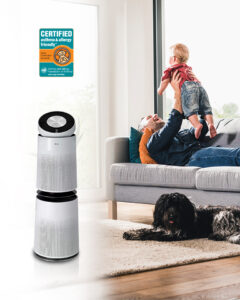 More than a few patients ask us if buying an air cleaner or air purifier helps control allergic symptoms. Running an air purifier can help to improve indoor air quality by filtering the air to remove odors and animal dander. The Air Purifier Buying Guide of March 2020 from Consumer Reports states that portable air purifiers with HEPA (high efficiency particulate air) filters can reduce particulate matter floating in the air by 50 percent or more.
More than a few patients ask us if buying an air cleaner or air purifier helps control allergic symptoms. Running an air purifier can help to improve indoor air quality by filtering the air to remove odors and animal dander. The Air Purifier Buying Guide of March 2020 from Consumer Reports states that portable air purifiers with HEPA (high efficiency particulate air) filters can reduce particulate matter floating in the air by 50 percent or more.
These are the various types of air purifiers:
- A mechanical air purifier uses pleated filters and fans to force air through the filter to trap particles
- A sorbent filter contains activated carbon and can absorb some odor-causing molecules from the air.
Questions come up about using machines that generate ozone to react with some pollutants. This type of device is not recommended by Consumer Reports because it does not remove pollutants and produces ozone in excess of FDA limits. Electrostatic precipitators and ionizers are not recommended by Consumer Reports because they can produce ozone.
Ultraviolet germicidal irradiation is also promoted to be effective for air purification. This method requires a powerful light and minutes to hours of exposure to be effective. Consumer Reports does not test this technology.
Photocatalytic oxidation is another touted method that uses ultraviolet radiation and a photo-catalyst to oxidize gaseous pollutants. When Consumer Reports tested the PECO air purifier by Molekule, the purifier did not remove dust, smoke or pollen well and can produce harmful byproducts.
Consumer Reports (CR) has tested air purifiers by injecting smoke and dust particles into a sealed chamber. The best air purifiers clear the air quickly, perform well at low speeds, avoid loud sounds and have a low annual operating cost for filters and energy use. An article from Consumer Reports dated January 10, 2020 and entitled “Best and Worse Air Purifiers of 2020” lists their 3 best and worse rated air-purifiers.
The three best (listed alphabetically)
- Blueair Blue Pure 211+ ($299) rated for 540 SQ FT
- Excellent particle removal at high and low speeds, annual running cost $195
- Blueair Classic 605 ($829)rated for 775 SQ FT
- Excellent particle removal at high and low speeds, annual running cost $225
- Honeywell HPA 300 ($250 – $350)rated for 465 SQ FT
- Good particle removal, very quiet at high speed, annual running cost $200
The three worst
- Hamilton Beach True Air 04383 ($60)
Poor in high speed and low speed cleaning, annual running cost $25
rated for 160 SQ FT
- Levoit LVH-132 ($90)
Poor rating for smoke and dust removal, annual running cost $50
rated for 129 SQ FT
- Molekule Air ($799) annual running cost $180
- rated for 100 SQ FT
- Poor score poor for particle removal at low speed and fair at high
We often rely on medication to solve our health problems. With allergies, sometimes it can be simpler to avoid the cause by removing it from the air. Air purifiers can provide the control we need with our indoor environments.
Yvette, RN, BSN